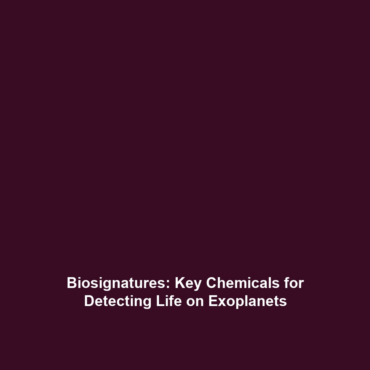The Role of Exoplanets in Speculative Fiction
Introduction
The exploration of exoplanets has catalyzed a surge of creativity in the realm of speculative fiction, enabling storytellers to envision complex habitable worlds and their ecosystems. With the discovery of thousands of exoplanets, writers are inspired to imagine not just the planets themselves, but the diverse forms of life, environments, and interstellar cultures that could thrive on these distant worlds. In this article, we delve into the significant role exoplanets play within speculative fiction and their broader implications for both literature and scientific discourse.
Key Concepts
Understanding Exoplanets
Exoplanets are planets located outside our solar system, orbiting stars in other star systems. The increasing capabilities of telescopes and space missions, such as Kepler and TESS, have allowed us to discover these intriguing worlds. They range from gas giants to rocky planets, including those in the habitable zone where liquid water could exist.
Imagining Habitable Worlds
Speculative fiction often extrapolates scientific theories about life and ecosystems to create believable worlds. Authors draw from current astrophysical knowledge to craft scenarios that explore potential civilizations, ecological relationships, and adaptive strategies that might occur on exoplanets. This melding of fact and fiction not only entertains but also educates audiences about the possibilities that exist beyond Earth.
Applications and Real-World Uses
Exploring how speculative fiction shapes public perception and scientific inquiry into exoplanets is crucial. Here are some significant applications:
- Inspiration for Research: The imaginative depictions of exoplanets can inspire real scientific research and exploration by framing questions about life beyond Earth.
- Public Engagement: Speculative narratives often capture the public’s interest, encouraging them to learn more about astronomy and the ongoing search for habitable planets.
- Cultural Reflection: Works of fiction often reflect society’s hopes and fears regarding extraterrestrial life and the future of humanity.
Current Challenges
Despite the fascinating intersections of exoplanets and speculative fiction, there are notable challenges:
- Scientific Accuracy: Balancing creative storytelling with the latest scientific discoveries can be difficult.
- Technological Limitations: Currently, our capacity to analyze exoplanets is limited by our technology, which may hinder accurate depictions.
- Public Misunderstanding: Fictional representations can sometimes distort public understanding of astrobiology and astrophysics.
Future Research and Innovations
The future of exoplanet exploration and its depiction in speculative fiction is bright. Upcoming missions, such as the James Webb Space Telescope, promise to unveil new insights into the atmospheres of exoplanets, potentially allowing for the discovery of biosignatures. As our understanding deepens, writers will continue to craft increasingly nuanced worlds, driven by scientific breakthroughs.
Conclusion
In conclusion, the role of exoplanets in speculative fiction is a remarkable fusion of science and imagination, leading to thrilling explorations of habitable worlds and diverse ecosystems. As scientific knowledge expands, so too does the creative potential within speculative literature, serving as a platform for discussion and contemplation about our place in the universe. To learn more about exoplanets and their significance in our future, consider exploring related topics such as astrobiology and space exploration missions.




